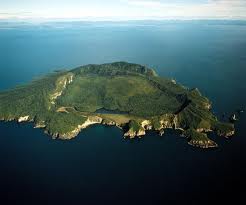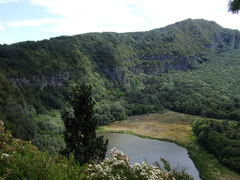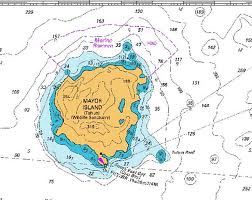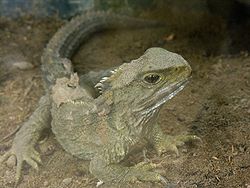
The tuatara is a reptile endemic to New Zealand which, though it resembles most lizards, is actually part of a distinct lineage, order Sphenodontia.[2][3] The two species of tuatara are the only surviving members of its order, which flourished around 200 million years ago.[3] Their most recent common ancestor with any other extant group is with the squamates (lizards and snakes). For this reason, tuatara are of great interest in the study of the evolution of lizards and snakes, and for the reconstruction of the appearance and habits of the earliest diapsids (the group that also includes birds, dinosaurs, and crocodiles).
Tuatara are greenish brown, and measure up to 80 cm (31 in) from head to tail-tip and weigh up to 1.3 kilograms (2.9 lb)[4] with a spiny crest along the back, especially pronounced in males. Their dentition, in which two rows of teeth in the upper jaw overlap one row on the lower jaw, is unique among living species. They are further unusual in having a pronounced photo-receptive eye dubbed the "third eye", whose current function is a subject of ongoing research but is thought to be involved in setting circadian and seasonal cycles. They are able to hear although no external ear is present, and have a number of unique features in their skeleton, some of them apparently evolutionarily retained from fish. Although tuatara are sometimes called "living fossils", recent taxonomic and molecular work has shown that they have changed significantly since the Mesozoic era.[5][6][7]
Story of the Tuatara
We lived at the mouth of the Kaituna River in the Bay of Plenty. My father was a Tuatara, and I was a Tuatara too. He was very caring. He, (there were no sexes in those ancient time, how long ago nobody remembers, possibly before the extinction of the dinosaurs), had laid his egg in the sand, and watched it, and protected it, and one day, I had hatched out. I knew this because later, when I tried to do the same thing, another Tuarara had come along and predated (eaten) it. This made me very angry for several reasons, but more of that later.
So why do I say we were male, when we were laying eggs? Because I know who my father is from his personality, and the fact I have seen various family members over the years.
Tuatara were quite spart. Let us say they were sentient, self aware, and with a few exceptions, kind to their young. The one which predated my eggs I will call Auntie Jess, because that is how she looked to me, and I can only assume she did it because it was an easy source of food, not because she wanted to reduce Tuatara competition. Tuatara had thought. Perhaps they had communication betwwen their minds, but it was my father who worked out that this was by means of a being called God, and asked God, "If there is a God (supreme being in the sky with the power to grant it) may I have my own son back next time I am here". Perhaps he already recognised me from an earlier life.
When I say smart, I mean we used to climb trees, and could triangulate to a certain extent. That is to say, he taught me that the distance we crawled out on a branch, was equal to the same distance from the ground, and we recognised the danger of falling. We could also line up branches below us, and by forming a triangle back to the tree trunk, roughly calculate the distance to the ground. Hard to explain, but if you are smart you will know what I mean. Imagine a right angled triangle, with the base on the ground, and several parallel lines running parallel to the ground.
One day he fell, or perhaps he tried to kill himself, I'm not sure. Anyway it was a long way down, even if he landed on sand. I went down to see what I could do, but there was very little. He wasn't moving. There were two types of tuatara character; those who were afraid of death, and sickness, and stayed away from it out of fear, and those who were concerned and who gathered around to try to assist.
The reason he called me his son, was because it was the same name he used for the sun. I'm not sure how long he lay there, but if it was overnight, he may have become too cold to revive himself. The other thing I don't know is whether I tried to bring him food. What I did do was try to make a picture of teh sun in my mind, to send to him to make him feel wwarm. Perhaps it worked. Perhaps we communicated with pictures, consciously, unconsciously or just shared emotions and feelings. I'm sure we had words and language. Anyway it did work, and he did come back to life and revive himself. Not all tuatara were so lucky, and I remember seeing dead ones on the beach.
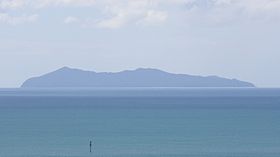
Mayor Island (or Tuhua) is a dormant shield volcano located off the Bay of Plenty coast of New Zealand's North Island. It lies 35 kilometres (22 mi) north of Tauranga and covers 13 km2 (5 sq mi). The island is quite steep along its coast and rises to 355 metres (1,165 ft) about sea level. A saddle about 75 metres (246 ft) deep separates it from the North Island, while the other side of the volcano rises from the seafloor some 400–500 metres (1,312–1,640 ft) beneath the waves.[1] The island is believed to have risen from the sea about 7000 years ago. Hot springs abound, and there are two small crater lakes, Green Lake and Black Lake. These lie within two overlapping calderas formed in explosive eruptions 36,000 and 6,340 years ago. Mayor Island has exhibited a wide range of eruptive styles, including fire fountains, Strombolian explosions, extrusion of lava domes, phreatomagmatic explosions, Plinian falls and ignimbrite. The most recent lava flows have been dated at between 500 and 1,000 years old.
The island is considered special by Māori (the indigenous people of Aotearoa/New Zealand) partly because of the presence of black obsidian, a volcanic glass created by the rapid cooling of silica-rich lava, prized as a cutting tool. The obsidian was called Tuhua by Māori who called the island by the same name. Captain James Cook called it Mayor Island when he sighted it on November 3, 1769, in recognition of the Lord Mayor's Day to be held in London a few days later.
The area of the Bay of Plenty around the island is renowned for game fishing, with marlin, mako sharks, and swordfish all inhabiting the surrounding waters. The island and the waters close to its shores, however, are now a small marine reserve. There are several tramping tracks around the island, and it is also popular with divers. Several pa sites are known on the island, which was inhabited until 1901. Mayor Island is actually closer to Waihi Beach than Tauranga.
Mayor Island today is a wildlife refuge. A small number of holiday houses are located in Opo Bay on the south coast of the island [2]. Currently a population of three is reported census of 2001, after zero in 1996 and 12 in 1991 (all figures randomised (for privacy) on a Base-3 system)[3]
The beach was not far from the coast, perhaps 100 metres. Ironically it is still just the same as I remember it, even though that was millions of years ago. There are pine trees there now, and there were pine trees there then, even though there were no pine trees in the country at that time. There is another story I have to tell, abot later when we were Maoiri people, and further up the river there were willow trees, which should not have been there before the European arrived, however I think the pine trees disappeared for quite a while.
My father must have died eventually, and that is when I tried to lay my eggs, and they kept getting eaten. At this I became so angry, so absolutely furious and in an extreme rage, that I resolved to swim out to a nearby island and live there. There was a closer island, Motiti, or as Captain Cook named it, Flat Island where later the Maori used to bury their dead, however I decided to bypass it and go directly to the one further out which is called Tuhua, and which Cook named Mayor Island.
For the first few hours I just swam and swam and swam toward my island, driven by my rage. I easily cruised past Motiti Island. Mayor is about 24 or 26 miles from the mouth of the Kaituna, (that is another story), although it is not so far from Tauranga (the place where the canoes ate tied up). Since a tuatara measures only six to eight inches long, I would be lucky to make one mile an hour. It is that reason I conclude I must have taken over a day to get there. About two thirds to three quarters of the way I was completely exhausted, and would have drowned, had I not come across a log. It wasn't exactly a log, it was a fence batton, one which had been cut square, about two inches square, and about five feet long. Climbing on top of it I rested, and was drifting closer with a tide or perhaps aaa wind from the south driving me there. After a time, I again took to the water and swam ashore. Where I landed is the beach called Southeast bay. There are rocky beaches on teh island, but possibly high cliffs. It was lucky for me that I came ashore where I did.
The unusually high abundance of iridium in the clay layer at the K–T geologic boundary gave rise to the Alvarez hypothesis that the impact of a massive extraterrestrial object caused the extinction of dinosaurs and many other species 65 million years ago. Iridium is found in meteorites with an abundance much higher than its average abundance in the Earth's crust.
Sphenodontia is an order of lizard-like reptiles that includes only one living genus, the tuatara (Sphenodon), and only two living species. Despite its current lack of diversity, the Sphenodontia at one time included a wide array of genera in several families, and represents a lineage stretching back to the Mesozoic Era.
e
s
o
z
o
i
c
Axis scale: millions of years ago.
The Mesozoic era is an interval of geological time from about 250 million years ago to about 65 million years ago. It is often referred to as the age of reptiles because reptiles, namely dinosaurs, were the dominant terrestrial and marine vertebrates of the time. The era began in the wake of the Permian-Triassic event, the largest mass extinction in Earth's history, and ended with the Cretaceous-Paleogene event, another mass extinction which is known for having killed off non-avian dinosaurs, as well as other plant and animal species.
Map sourced from NZ541. Crown Copyright Reserved. Depths in metres. Mayor Island is known to Maori as Tuhua. It is 22 nautical miles from Mount Maunganui in the Bay of Plenty. The Island was made famous for the quality of its big game fishing by the angling author Zane Grey. The crystal clear waters around Mayor Island still offer some of the finest sea fishing for snapper, kingfish, and many other species, to be found anywhere in New Zealand. A marine reserve was established at the northern end of the island in 1993. The reserve covers approximately three square nautical miles from mean high water to one nautical mile offshore. The island itself covers 1,277 hectares. Landing is by is by permission of the owners (Tuhua Trust Board) only and requires adherence to biosecurity protocols and quarantine restrictions to help keep Tuhua pest-free.
It wasn't too long before I succesfully laid and hatched an egg, and I'm pretty sure that it came out Sladja, and/or Eva, whose stories I have already related, but before we get there there is more. Mayor Island is now a beautiful tree covered island with abundant bird life. I can't say for sure that it was the same back then, but we did have a thriving colony of Tuatara which survives to this very day.
There was a dark time I remember, when we were blackened by an event which caused everything to become vey cold, but we hid in our little caves and we survived. It was the extinction of the dinosaurs by a meteorite striking near Mexico, which deposited a layer of iridium over most of the planet.
Then there was the time I left the island, perhaps for the last time. My daughter (Sladja?) was there. Some people arrived. They appeard not to know what a tuatara was, and since I was old, I went forward to sacrifice myself for food. I knew they would find me bitter and unpaletable, but had yet to learn it. My daughter didn't want me to do it, because she loved me alive, but there wasn't much time left for me anyway. As expected, they didn't like the taste. Tuatara have co-existed on teh island with peoplle ever sinse.
The tuatara is a dangerous animal. He can stand on his hind lega, and he can call down fire and lightning from the sky. He is a friend of God, and God knows every one of them by name.
